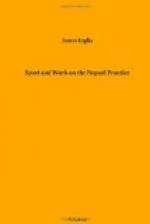[1] The rahur is a kind of pea, growing not
unlike our English broom
in appearance; it is sown
with the maize crop during the rains,
and garnered in the cold weather.
It produces a small pea, which
is largely used by the natives,
and forms the nutritive article of
diet known as dhall.
CHAPTER II.
My first charge.—How we get our lands.—Our home farm.—System of farming.—Collection of rents.—The planter’s duties.
My first charge was a small outwork of the large factory Seeraha. It was called Puttihee. There was no bungalow; that is, there was no regular house for the assistant, but a little one-roomed hut, built on the top of the indigo vats, served me for a residence. It had neither doors nor windows, and the rain used to beat through the room, while the eaves were inhabited by countless swarms of bats, who, in the evening flashed backwards and forwards in ghostly rapid flight, and were a most intolerable nuisance. To give some idea of the duties of an indigo assistant, I must explain the system on which we get our lands, and how we grow our crop.
Water of course being a sine qua non, the first object in selecting a site for a factory is, to have water in plenty contiguous to the proposed buildings. Consequently Puttihee was built on the banks of a very pretty lake, shaped like a horseshoe, and covered with water lilies and broad-leaved green aquatic plants. The lake was kept by the native proprietor as a fish preserve, and literally teemed with fish of all sorts, shapes, and sizes. I had not been long at Puttihee before I had erected a staging, leading out into deep water, and many a happy hour I have spent there with my three or four rods out, pulling in the finny inhabitants.
Having got water and a site, the next thing is to get land on which to grow your crop. By purchase, by getting a long lease, or otherwise, you become possessed of several hundred acres of the land immediately surrounding the factory. Of course some factories will have more and some less as circumstances happen. This land, however, is peculiarly factory property. It is in fact a sort of home farm, and goes by the name of Zeraat. It is ploughed by factory bullocks, worked by factory coolies, and is altogether apart and separate from the ordinary lands held by the ryots and worked by them. (A ryot means a cultivator.) In most factories the Zeraats are farmed in the most thorough manner. Many now use the light Howard’s plough, and apply quantities of manure.
The fields extend in vast unbroken plains all round the factory. The land is worked and pulverised, and reploughed, and harrowed, and cleaned, till not a lump the size of a pigeon’s egg is to be seen. If necessary, it is carefully weeded several times before the crop is sown, and in fact, a fine clean stretch of Zeraat in Tirhoot or Chumparun, will compare most favourably with any field in the highest farming districts of England or Scotland. The ploughing and other farm labour is done by bullocks. A staff of these, varying of course with the amount of land under cultivation, is kept at each factory. For their support a certain amount of sugar-cane is planted, and in the cold weather carrots are sown, and gennara, a kind of millet, and maize.




